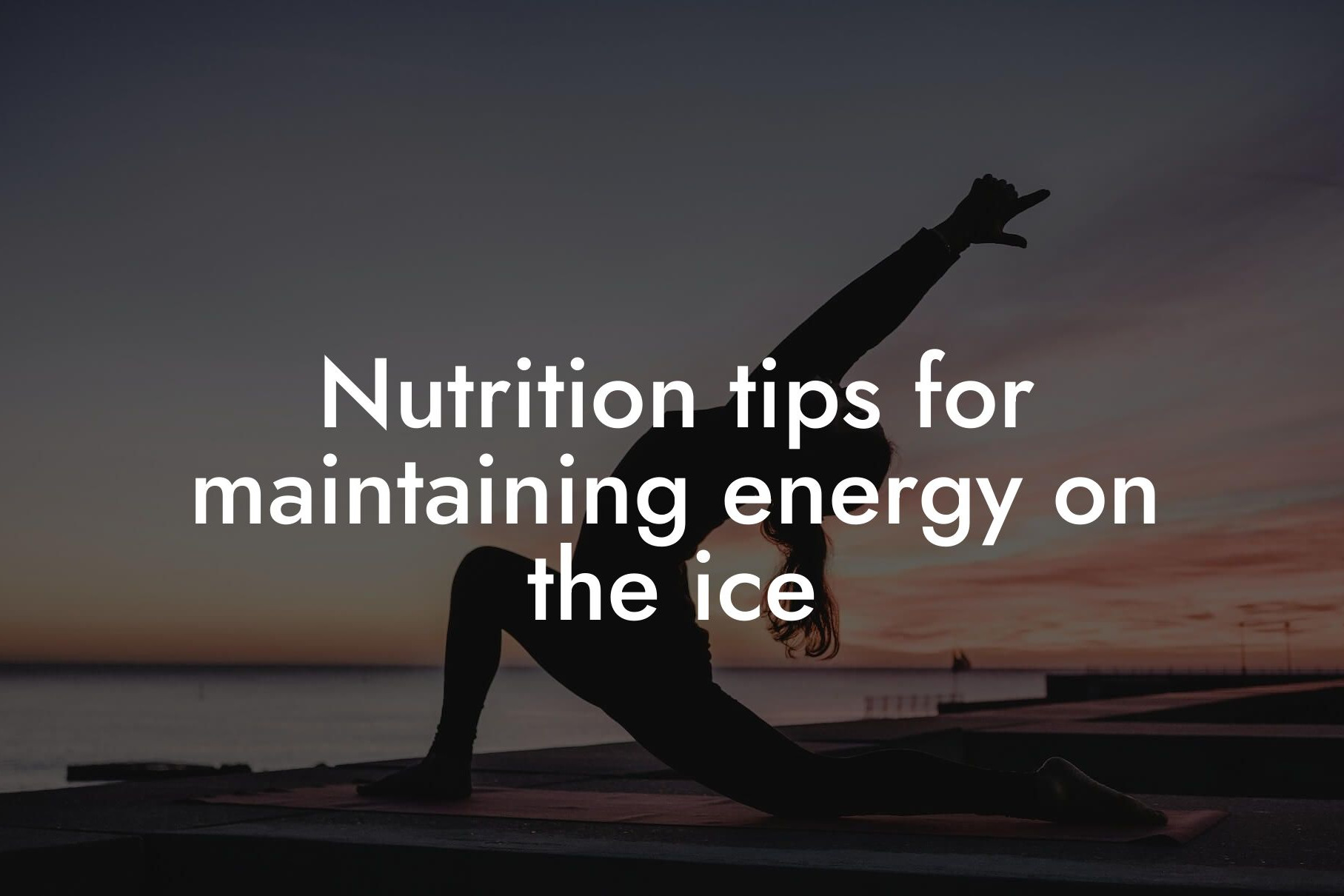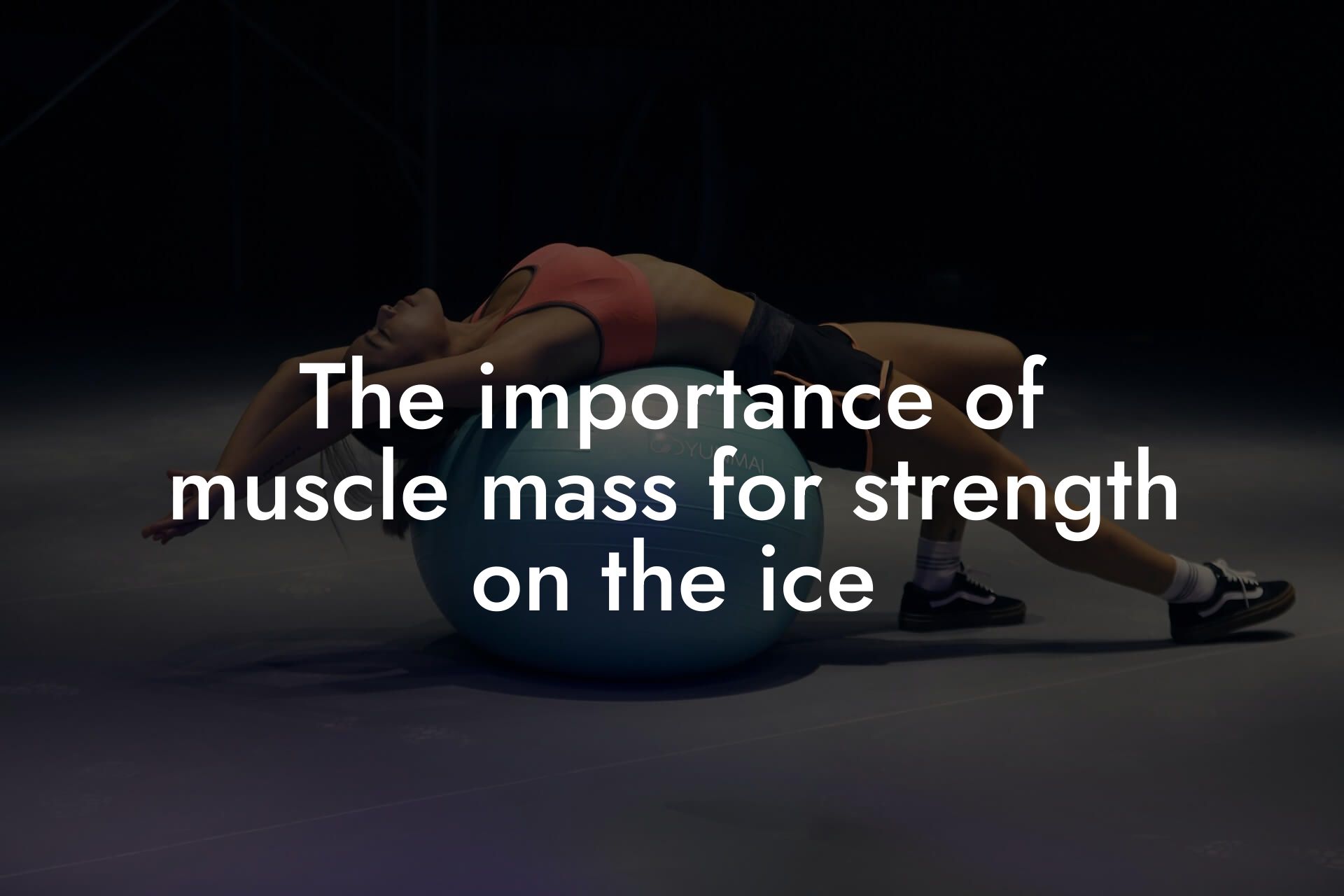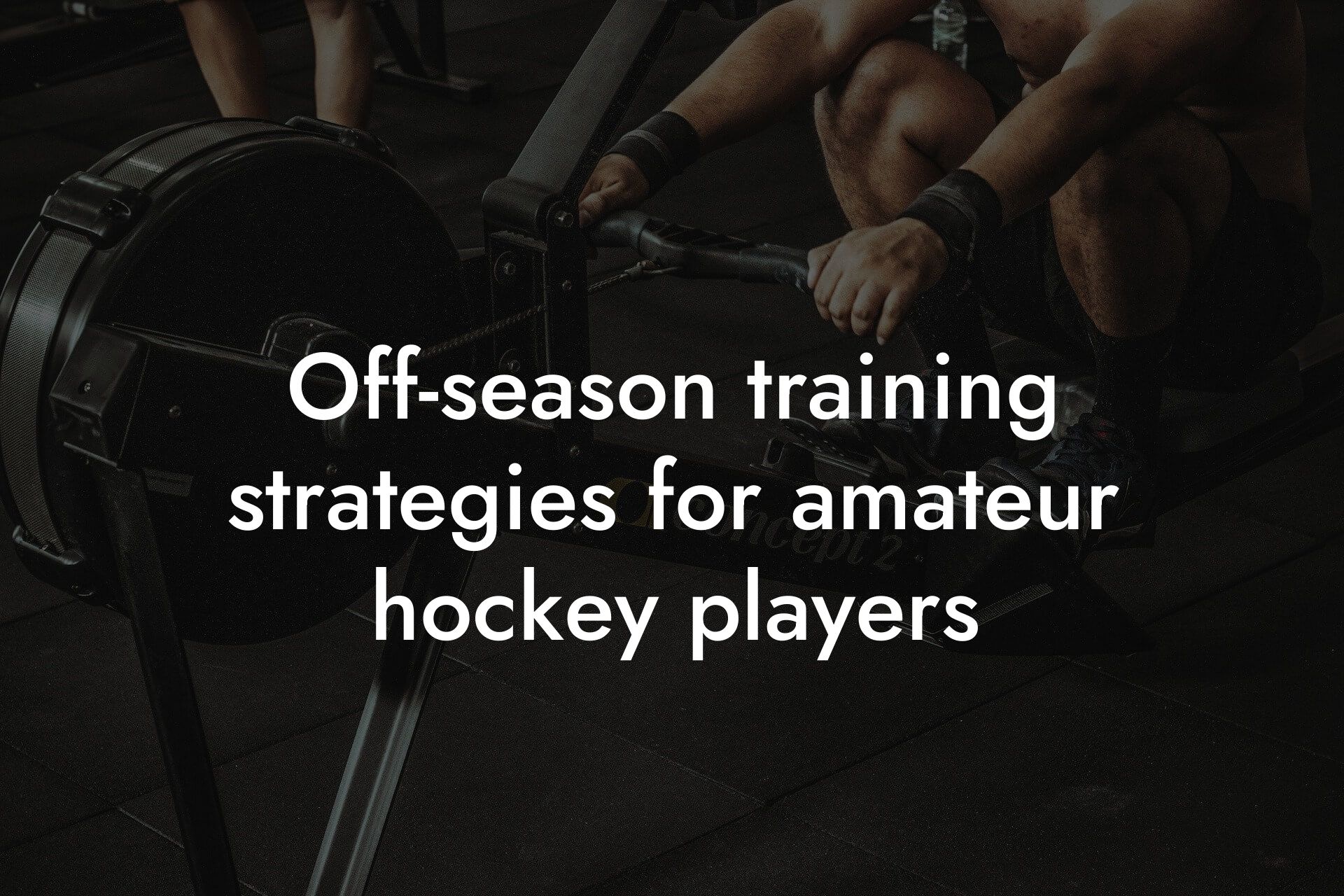Introduction
As a hockey player, you understand the importance of speed and agility on the ice. However, excess body fat can hinder your performance, making it difficult to achieve your goals. Reducing body fat is crucial to improve your overall game, and at Tano Performance Group, we're committed to helping high-earning professionals like you achieve their physical goals. In this article, we'll delve into the importance of reducing body fat for better speed and agility in hockey, and provide you with a comprehensive guide to get you started.
Table of Contents
Why Body Fat Matters in Hockey
Excess body fat can negatively impact your hockey performance in several ways. Firstly, it increases your overall weight, making it more difficult to accelerate and decelerate on the ice. This can lead to slower reaction times, reduced agility, and decreased endurance. Additionally, excess body fat can also affect your power-to-weight ratio, making it harder to generate speed and explosiveness. Furthermore, carrying excess body fat can increase your risk of injury, particularly in the knees, hips, and lower back.
The Ideal Body Fat Percentage for Hockey Players
The ideal body fat percentage for hockey players varies depending on factors such as age, position, and level of play. However, a general guideline is to aim for a body fat percentage between 10-15% for male players and 16-20% for female players. Having a body fat percentage within this range can help you maintain a high level of speed, agility, and endurance while reducing your risk of injury.
DEXA Scanning: The Most Accurate Way to Measure Body Fat
At Tano Performance Group, we use Dual-Energy X-ray Absorptiometry (DEXA) scanning to provide our clients with an accurate measurement of their body fat percentage. DEXA scanning is a non-invasive, pain-free procedure that uses X-rays to measure bone density and body composition. This advanced technology provides a detailed breakdown of your body fat percentage, lean muscle mass, and bone density, giving you a comprehensive understanding of your overall body composition.
Nutrition Strategies for Reducing Body Fat
To reduce body fat, you need to focus on creating a calorie deficit while maintaining a balanced diet that provides your body with the necessary nutrients for optimal performance. Here are some nutrition strategies to help you achieve your goals:
1. Eat protein-rich foods: Protein takes more energy to digest than carbohydrates or fats, which can help increase your metabolism and reduce body fat. Aim for 1.6-2.2 grams of protein per kilogram of body weight.
2. Incorporate healthy fats: Healthy fats such as avocado, nuts, and seeds provide energy and support hormone function. Aim for 0.5-1 gram of healthy fats per kilogram of body weight.
3. Focus on complex carbohydrates: Complex carbohydrates such as whole grains, fruits, and vegetables provide energy and fiber. Aim for 2-3 grams of complex carbohydrates per kilogram of body weight.
4. Hydrate adequately: Adequate hydration is essential for optimal performance and fat loss. Aim for at least 8-10 glasses of water per day.
5. Avoid processed foods: Processed foods are high in sugar, salt, and unhealthy fats, which can hinder your fat loss efforts. Opt for whole, nutrient-dense foods instead.
Training Strategies for Reducing Body Fat
In addition to a balanced diet, a well-structured training program can help you reduce body fat and improve your overall hockey performance. Here are some training strategies to consider:
1. High-Intensity Interval Training (HIIT): HIIT involves short bursts of high-intensity exercise followed by active recovery. This type of training can help you burn fat and improve your anaerobic endurance.
2. Resistance Training: Resistance training can help you build lean muscle mass, which can further enhance your metabolism and fat loss efforts. Focus on exercises that target your core, legs, and glutes.
3. Plyometric Training: Plyometric training involves explosive movements such as jump squats and box jumps. This type of training can help improve your power and speed on the ice.
4. Cardiovascular Training: Cardiovascular training such as cycling, swimming, or jogging can help you burn fat and improve your cardiovascular endurance. Aim for at least 20-30 minutes of moderate-intensity cardio per session.
Sample Workout Plan
Here's a sample workout plan that you can follow to reduce body fat and improve your hockey performance:
Monday (Upper Body and Cardio):
- Warm-up: 10-15 minutes of light cardio
- Resistance Training: 3 sets of 10-12 reps of push-ups, dumbbell rows, and shoulder press
- Cardio: 20-30 minutes of cycling or jogging
Wednesday (Lower Body and Plyometrics):
- Warm-up: 10-15 minutes of light cardio
- Resistance Training: 3 sets of 10-12 reps of squats, lunges, and deadlifts
- Plyometric Training: 3 sets of 10-12 reps of jump squats and box jumps
Friday (Core and Cardio):
- Warm-up: 10-15 minutes of light cardio
- Core Training: 3 sets of 10-12 reps of planks, Russian twists, and leg raises
- Cardio: 20-30 minutes of swimming or rowing
Reducing body fat is crucial for improving your speed and agility in hockey. By following the nutrition and training strategies outlined in this article, you can achieve your goals and take your game to the next level. Remember to stay hydrated, get enough sleep, and listen to your body to avoid injury. At Tano Performance Group, we're committed to helping high-earning professionals like you achieve their physical goals. Contact us today to learn more about our DEXA scanning services and how we can help you achieve your hockey goals.
Frequently Asked Questions
What is the ideal body fat percentage for hockey players?
For hockey players, the ideal body fat percentage varies depending on the position and individual goals. Generally, a body fat percentage between 8-12% is considered optimal for most players. However, some studies suggest that elite players may have body fat percentages as low as 6-8%. It's essential to consult with a qualified coach or trainer to determine the ideal body fat percentage for your specific needs and goals.
How does excess body fat affect my speed and agility on the ice?
Excess body fat can significantly impede your speed and agility on the ice. Carrying extra weight increases your energy expenditure, making it more difficult to accelerate, decelerate, and change direction quickly. Additionally, excess body fat can also affect your power-to-weight ratio, making it harder to generate speed and explosiveness.
What are the benefits of reducing body fat for hockey players?
Reducing body fat can have numerous benefits for hockey players, including improved speed, agility, and endurance. It can also enhance power, acceleration, and overall performance. Furthermore, reducing body fat can reduce the risk of injury, improve recovery, and boost overall confidence and self-esteem.
How can I measure my body fat percentage?
There are several ways to measure body fat percentage, including skinfold measurements, bioelectrical impedance analysis (BIA), dual-energy X-ray absorptiometry (DXA), and hydrostatic weighing. It's essential to consult with a qualified professional to determine the most accurate and reliable method for your individual needs.
What is the best way to reduce body fat for hockey players?
A comprehensive approach that combines a healthy diet, regular exercise, and proper recovery strategies is the most effective way to reduce body fat for hockey players. Focus on consuming a balanced diet that is high in protein, moderate in complex carbohydrates, and low in unhealthy fats. Incorporate resistance training and high-intensity interval training (HIIT) into your workout routine, and prioritize adequate rest and recovery.
How many calories should I consume daily to reduce body fat?
The daily caloric intake required to reduce body fat varies depending on individual factors such as age, sex, weight, and activity level. A general rule of thumb is to create a caloric deficit of 500-1000 calories per day through a combination of diet and exercise. Consult with a qualified nutritionist or coach to determine the ideal caloric intake for your specific needs and goals.
What are the best exercises for reducing body fat for hockey players?
A well-rounded exercise program that includes a combination of resistance training, plyometrics, and cardio exercises is essential for reducing body fat for hockey players. Focus on exercises that target multiple muscle groups at once, such as squats, deadlifts, and lunges. Incorporate plyometric exercises like box jumps and depth jumps to improve power and explosiveness.
How often should I exercise to reduce body fat?
Aim to exercise at least 3-4 times per week, with a minimum of 2-3 resistance training sessions and 1-2 cardio sessions. Incorporate active recovery days, such as light yoga or stretching, to aid in recovery and reduce muscle soreness.
What is the role of nutrition in reducing body fat for hockey players?
Nutrition plays a critical role in reducing body fat for hockey players. Focus on consuming a balanced diet that is high in protein, moderate in complex carbohydrates, and low in unhealthy fats. Prioritize whole, nutrient-dense foods like lean meats, fruits, and vegetables, and avoid processed and high-calorie foods.
How can I stay motivated to reduce body fat?
Staying motivated to reduce body fat requires a combination of goal-setting, accountability, and positive reinforcement. Set specific, measurable, and achievable goals, and track your progress regularly. Find a workout buddy or join a training group to provide accountability and support. Celebrate small victories along the way, and focus on the positive changes you're making to your body and overall health.
How long does it take to notice improvements in speed and agility?
The time it takes to notice improvements in speed and agility varies depending on individual factors such as training experience, diet, and overall fitness level. However, with consistent and dedicated training, most hockey players can expect to notice improvements in speed and agility within 6-12 weeks.
What are the risks of rapid weight loss for hockey players?
Rapid weight loss can have several risks for hockey players, including decreased muscle mass, reduced strength and power, and increased risk of injury. Additionally, rapid weight loss can also lead to decreased endurance and overall performance. It's essential to prioritize a slow and steady approach to weight loss, focusing on sustainable lifestyle changes rather than quick fixes.
How can I maintain my body fat percentage during the off-season?
Maintaining your body fat percentage during the off-season requires a combination of consistent training, healthy nutrition, and active recovery. Focus on maintaining a balanced diet, incorporating strength training and cardio exercises, and prioritizing rest and recovery. Avoid complacency and stay motivated by setting off-season goals and tracking your progress.
What are the benefits of high-intensity interval training (HIIT) for hockey players?
HIIT is an effective training method for hockey players, offering numerous benefits including improved speed, agility, and endurance. HIIT also enhances power, acceleration, and overall performance, while reducing body fat and improving insulin sensitivity.
How can I incorporate plyometric exercises into my training program?
Plyometric exercises, such as box jumps and depth jumps, can be incorporated into your training program 1-2 times per week. Start with lower intensities and volumes, gradually increasing as you build power and explosiveness. Focus on proper technique and safety, and incorporate plyometric exercises into your strength training or cardio workouts.
What is the role of protein in reducing body fat for hockey players?
Protein plays a critical role in reducing body fat for hockey players, as it helps to build and maintain lean muscle mass. Aim to consume 1.6-2.2 grams of protein per kilogram of body weight daily, spread across 3-5 meals. Prioritize lean protein sources like chicken, fish, and lean beef, and avoid high-calorie protein supplements.
How can I reduce body fat while still building muscle?
Reducing body fat while building muscle requires a combination of proper nutrition, consistent training, and patience. Focus on consuming a calorie-controlled diet that is high in protein and moderate in complex carbohydrates, while incorporating resistance training and HIIT exercises. Prioritize progressive overload and adequate rest and recovery to support muscle growth and fat loss.
What are the benefits of active recovery for hockey players?
Active recovery, such as light yoga or stretching, offers numerous benefits for hockey players, including improved flexibility, reduced muscle soreness, and enhanced recovery. Active recovery can also reduce the risk of injury, improve overall performance, and boost mental well-being.
How can I track my progress and stay accountable?
Tracking your progress and staying accountable requires a combination of goal-setting, measurement, and accountability. Set specific, measurable, and achievable goals, and track your progress regularly using tools like body fat calipers, weight scales, and performance metrics. Share your goals and progress with a workout buddy or coach to provide accountability and support.
What are the risks of low body fat percentage for hockey players?
A very low body fat percentage can have several risks for hockey players, including decreased muscle mass, reduced strength and power, and increased risk of injury. Additionally, a very low body fat percentage can also lead to decreased endurance and overall performance. It's essential to prioritize a healthy and sustainable body fat percentage, rather than striving for an unrealistically low percentage.
How can I maintain my motivation and enthusiasm for training?
Maintaining motivation and enthusiasm for training requires a combination of goal-setting, variety, and positive reinforcement. Set specific, measurable, and achievable goals, and celebrate small victories along the way. Incorporate new exercises and training methods to avoid plateaus, and prioritize rest and recovery to avoid burnout. Find a workout buddy or join a training group to provide accountability and support.
Here are some related articles you might love...
- Nutrition tips for maintaining energy on the ice
- The importance of muscle mass for strength on the ice
- Off-season training strategies for amateur hockey players
- Recovery techniques for hockey athletes after games
- How body composition affects hockey performance
- Strength and conditioning programs for hockey players
- The benefits of DEXA scans for amateur hockey players
- Balancing strength, speed, and agility in hockey
- Bone density and injury prevention in hockey
Zak Faulkner
Zak Faulkner is a leading authority in the realm of physical health and body composition analysis, with over 15 years of experience helping professionals optimise their fitness and well-being. As one the experts behind Tano Performance Group, Zak has dedicated his career to providing in-depth, science-backed insights that empower clients to elevate their physical performance and overall health.
With extensive knowledge of DEXA technology, Zak specializes in delivering comprehensive body assessments that offer precise data on body fat, muscle mass, bone density, and overall physique. His expertise enables individuals to make informed decisions and achieve their fitness goals with accuracy and confidence. Zak’s approach is rooted in a deep understanding of human physiology, combined with a passion for helping clients unlock their full potential through personalised strategies.
Over the years, Zak has earned a reputation for his commitment to excellence, precision, and client-focused service. His guidance is trusted by top professionals who demand the best when it comes to their health. Whether advising on fitness programs, nutritional strategies, or long-term wellness plans, Zak Faulkner’s insights are a valuable resource for anyone serious about taking their health and fitness to the next level.
At Tano Performance Group, Zak continues to lead our Content Team revolutionising how professionals approach their physical health, offering unparalleled expertise that drives real results.




